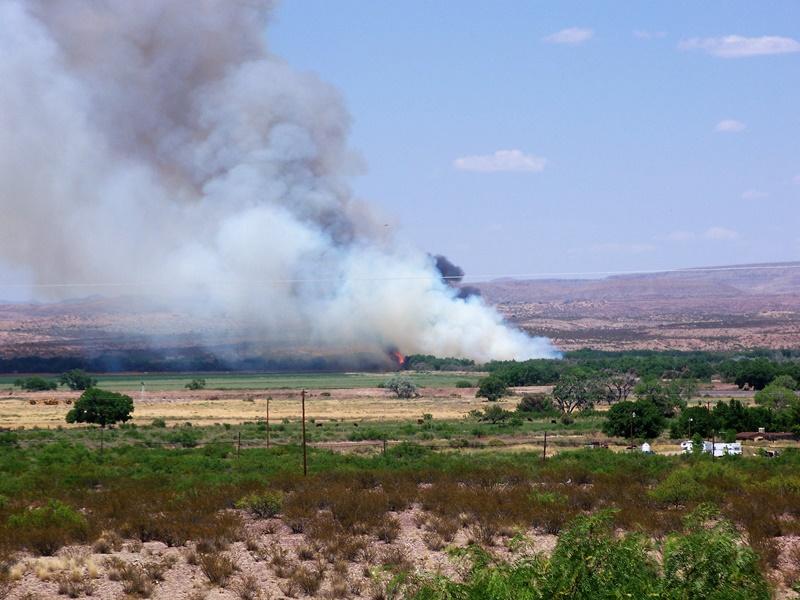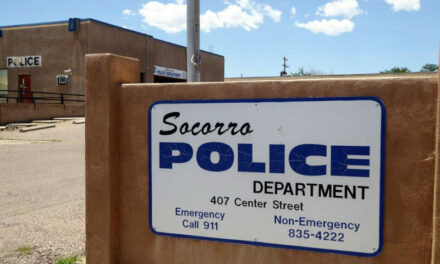Although the fire season in our corner of New Mexico is, for all practical purposes year-round, the hotter, dryer spring and summer months pose a significant problem and at least one wildland fire has already cropped up in the valley.
According to the Forestry Division of New Mexico’s Energy, Minerals and Natural Resources Department, the Big Hole Fire, located north of River Road in the community of Belen is estimated as of Tuesday at 900 acres and 0% contained.
The fire was discovered early Monday afternoon and transitioned to a Type 3 organization by Monday evening. The cause of the Big Hole fire is under investigation.
The fire is burning on both sides of the Rio Grande and continues to threaten nearby structures. Evacuations for residents of approximately 200 homes have been lifted, and are currently only voluntary as of Wednesday. One residence and 18 outbuildings have been confirmed damaged or destroyed in the fire.
Approximately 100 firefighters from multiple agencies are assisting the Forestry Division and Valencia County Fire Department, including the BLM and local volunteer fire departments.
Historically, New Mexico’s fire danger is highest in the spring, when red flag conditions are common. It is important to be prepared and reduce your property’s wildfire risk.

Wildland fires along the bosque, like this one in 2017, are more likely in the spring and summer.
File photo
Socorro County has seen several wildland fires over the last several years, both along the bosque and Cibola National Forest.
A wildfire protection plan updated last year by Socorro County pointed out that “with increased residential growth in or near the forest boundary and the bosque areas, the risk from catastrophic wildfire has increased dramatically. Private inholdings are being developed with multiple structures and limited access. This growth has also increased the traffic on our roadways, resulting in safety concerns both for emergency response and urban interface fire evacuations.”
The area receives an abnormally high number of lightning storms and ground strikes, due mainly to the topographical change from desert to rolling mountains; and receives only six inches of rainfall, annually in lower elevations, to 30 inches in the higher elevations above 10,000 feet, annually.
The county fire Marshal and State Forestry say taking steps to harden your home and create defensible space is the best way to reduce the threat of wildfire.
Start by focusing on areas around the outside of your house and the exteriors of barns, sheds and other structures where a ground fire could potentially reach your home. When wildfire threatens, low-hanging trees, excessive dead vegetation and wood piles next to your house exponentially increase the risk of home ignition.
Take the time to identify vulnerable areas that need to be addressed before a wildfire appears.
While one may not see the flames, wind can carry hot embers from burning vegetation or other materials at least a mile or more away from an active wildfire. Start with the top of the structure, work down to the ground, and then work out from there.
- Trees. Cut down any dead trees close to your home. Remove overhanging limbs, especially dead ones
- Shrubs. Thin shrubs throughout your yard and remove dead vegetation. If shrubs are touching the exterior of your home, replant them further away or make sure they stay green, watered and thinned throughout the fire season
- Exterior of Home. Build or remodel with fire-resistant materials. Consider using xeriscape landscaping and non-flammable materials within 5 feet of your home. Remove plants that climb up the wall and under eaves
- Decks/Balconies. Enclose the foundation and undersides of decks and balconies with flame-resistant sheeting or metal screens. Use fire-resistant decking and outdoor furniture. Keep deck clear of combustible items like leaves and pine needles
- Combustibles. Relocate woodpiles away from structures, including sheds and barns. Clear at least a 10-foot area around your propane tank. Keep your grill and propane cylinders at least 10 feet from any structure. Never store propane cylinders in the basement, garage or shed. Think about acquiring an outdoor flammables cabinet and clearly label it for firefighters’ knowledge.



















